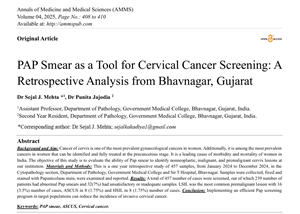PAP Smear as a Tool for Cervical Cancer Screening: A Retrospective Analysis from Bhavnagar, Gujarat
Authors
##plugins.themes.bootstrap3.article.main##
Abstract
Background and Aim: Cancer of cervix is one of the most prevalent gynaecological cancers in women. Additionally, it is among the most prevalent cancers in women that can be identified and fully treated at the precancerous stage. It is a leading cause of morbidity and mortality of women in India. The objective of this study is to evaluate the ability of Pap smear to identify nonneoplastic, malignant, and premalignant cervix lesions at our institution. Materials and Methods: This is a one year retrospective study of 457 samples, from January 2024 to December 2024, in the Cytopathology section, Department of Pathology, Government Medical College and Sir T Hospital, Bhavnagar. Samples were collected, fixed and stained with Papanicolaou stain, were examined and reported. Results: A total of 457 number of cases were screened, out of which 239 number of patients had abnormal Pap smears and 32(7%) had unsatisfactory or inadequate samples. LSIL was the most common premalignant lesion with 16 (3.5%) number of cases, ASCUS in 8 (1.75%) and HSIL in 8 (1.75%) number of cases. Conclusion: Implementing an efficient Pap screening program in target populations can reduce the incidence of invasive cervical cancer.
##plugins.themes.bootstrap3.article.details##
Copyright (c) 2025 Dr Sejal J. Mehta, Dr Punita Jajodia

This work is licensed under a Creative Commons Attribution 4.0 International License.
Creative Commons License All articles published in Annals of Medicine and Medical Sciences are licensed under a Creative Commons Attribution 4.0 International License.
[1] Hemali J. Tailor, Patel R.D., Prashant R. Patel*, Vasudha M. Bhagat. Study of cervical pap smears in a tertiary care hospital of south Gujarat, India.
[2] Sutanuka Khasnabish, Ramit Chakraborty, Debaprasad Chakraborty, Ganes Chandra Hati. Study Of Cervical Pap Smear Study and Its Utility in Cancer Screening- An Experience in a Tertiary Care Hospital of Tripura, North Eastern State of India.
[3] WHO/ICO Information Centre on HPV and Cervical Cancer (HPV Information Centre). Summary report on HPV and cervical cancer statistics in India.2007.
[4] Chavez LR, Hubbell FA. The influence of fatalism on selfreported use of Papanicolaousmears. Am J Prev Med 1997; 13:418-24.
[5] Walboomers JM, Jacobs. Human papillomavirus is a necessary cause of invasive caner worldwide. J Pathol 1999; 189:12-9.
[6] Pontin J et al. Strategies for global control of cervical cancer. International Journal of Cancer, 1995,60(1):1-26.
[7] Paskett ED, White E,. Improving follow-up after an abnormal Pap smear: A randomized controlled trial. Prev Med 1990; 19:630-41.
[8] Sutanuka Khasnabish, Ramit Chakraborty, Debaprasad Chakraborty, Ganes Chandra Hati. Study Of Cervical Pap Smear Study and Its Utility in Cancer Screening- An Experience in a Tertiary Care Hospital of Tripura, North Eastern State of India.
[9] Denny L, Sankaranarayanan R. Secondary prevention of cervical cancer. Int J Gynaecol Obstet.2006;94(1):S65-70.
[10] Hakama M, Rasanen-Virtanen U. Effectiveness of mass screening program on the risk of cervical cancer. Am J Epidemiol. 1989;(17):173-204.
[11] Nandakumar A, Ramnath T, Chaturvedi M. The magnitude of cancer cervix in India. Indian J Med Res.2009;130(3):219-21.

